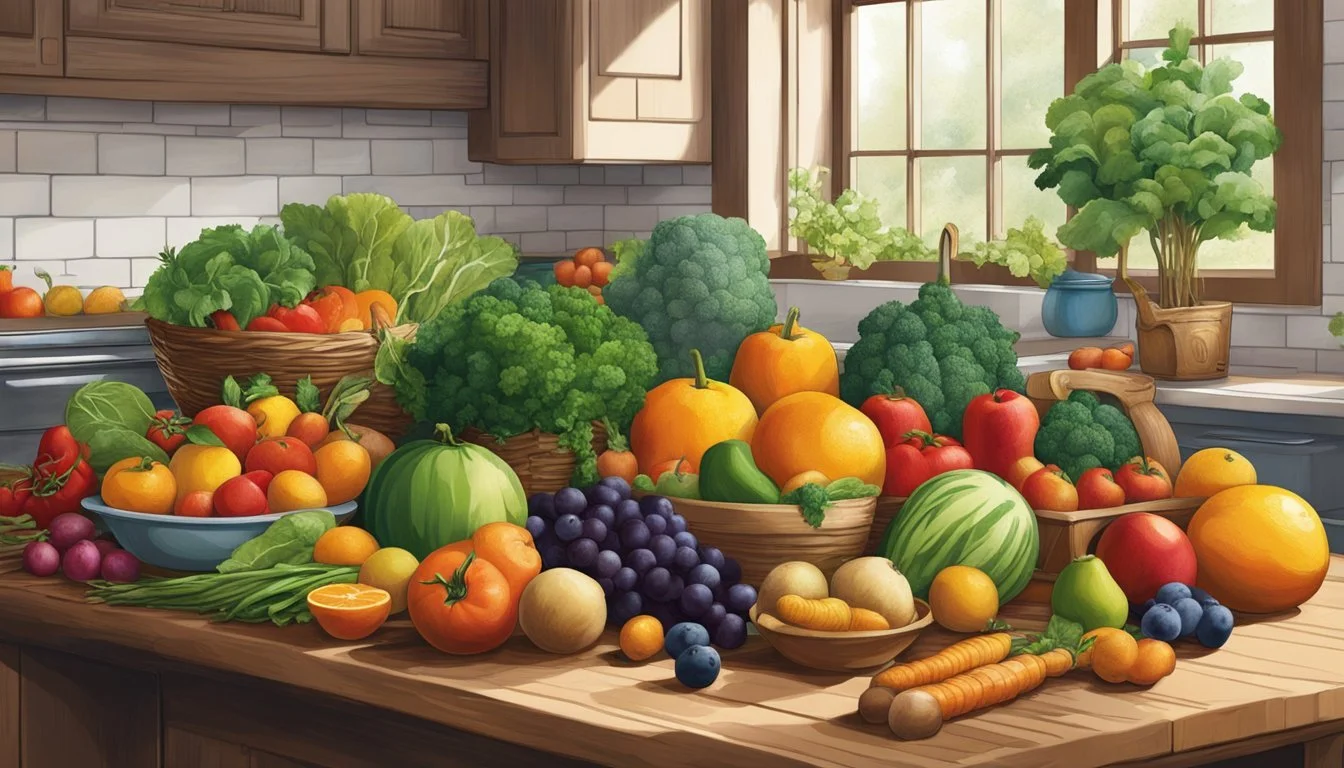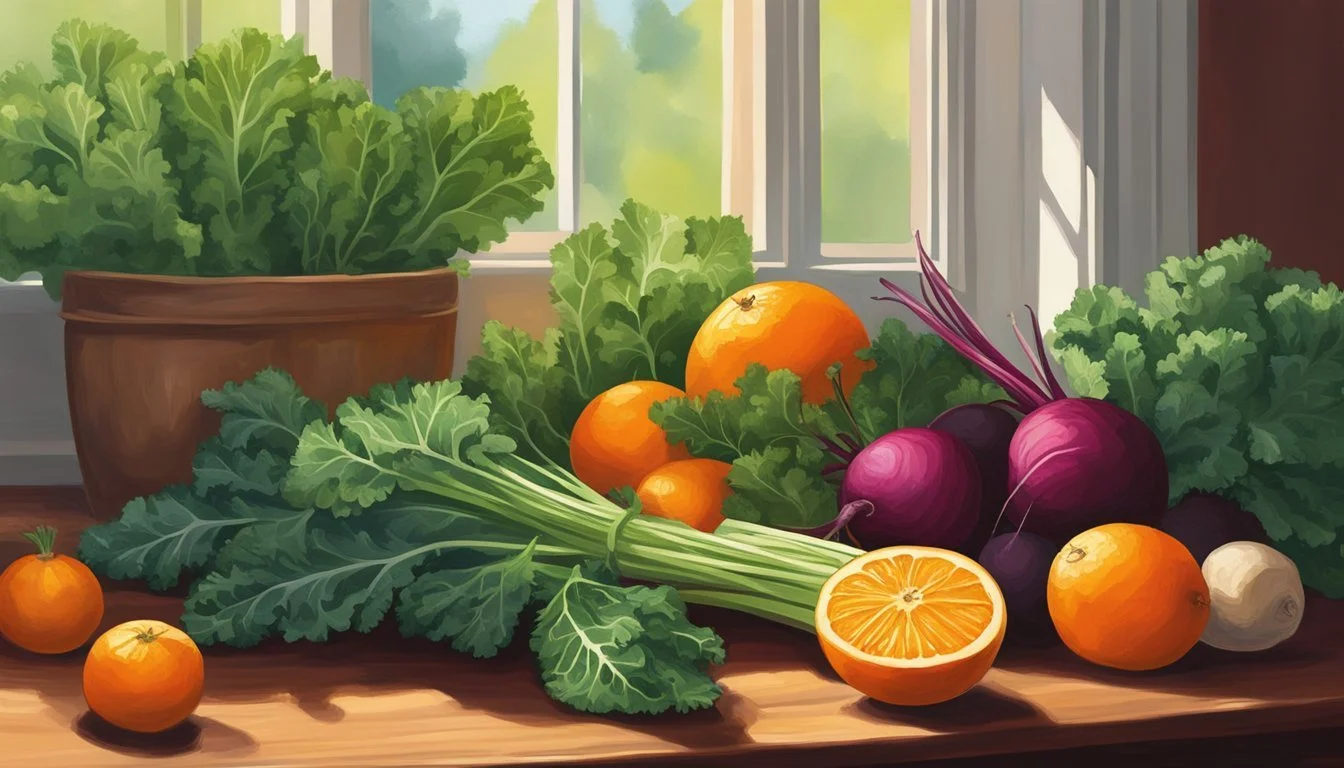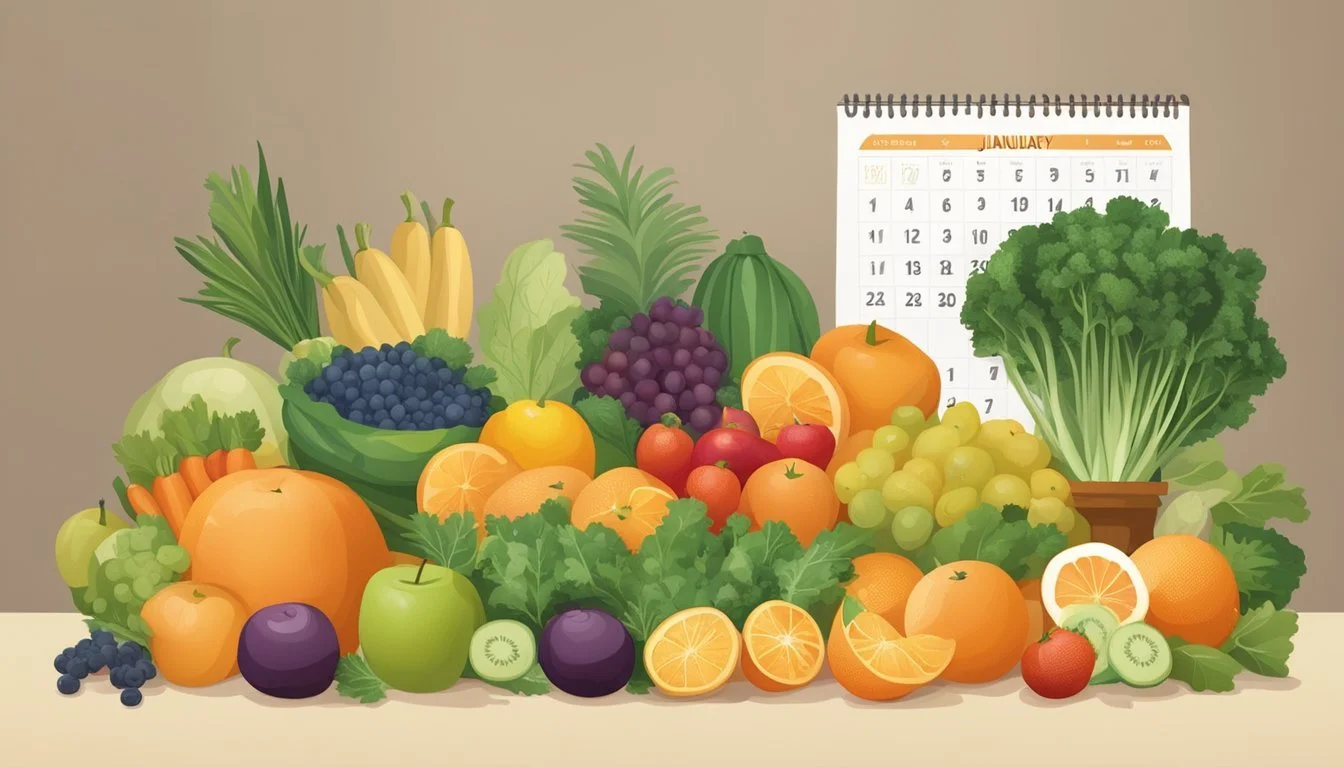Georgia Seasonal Fruit & Vegetables in January
A Guide to Fresh Produce Selection
This Article is Part of our Georgia Seasonal Fruit & Veg Calendar
Georgia's climate offers a diverse range of growing conditions which allows for an extensive variety of fruits (What wine goes well with fruit?) and vegetables to thrive throughout the year. In the month of January, Georgia's fields and orchards are not as bountiful as the warmer months, yet they still provide a rich harvest of cool-weather crops. Shoppers at farmers markets and local grocers can expect to find produce that not only withstands the chill but also enjoys it, leading to crisp textures and concentrated flavors.
Among the fruits, the citrus family makes a prominent showing. While Georgia is not widely recognized for citrus production, local farms may offer a modest selection of these tangy fruits during this time. Vegetables, on the other hand, are quite abundant, with hearty greens like kale and collard greens (how long do collard greens last?) available, which are both nutritious and versatile in the kitchen. Root vegetables also continue to be stalwarts of the winter table, with varieties such as carrots and turnips stored from fall harvests.
These winter offerings are not only a testament to Georgia’s rich agricultural heritage but also provide an opportunity for consumers to enjoy fresh, locally-grown produce even during the cooler season. The practice of eating seasonally ensures the freshest produce and supports the local economy, a win-win for the health-conscious and community-minded Georgian.
Overview of Georgia's Seasonal Produce
Georgia's produce calendar is deeply influenced by the state's diverse climate and geography. The month of January is a crucial time for seasonal eating and understanding the agricultural patterns within the state.
Importance of Seasonal Eating in Georgia
Eating seasonally in Georgia means enjoying fruits and vegetables at the peak of their freshness and nutritional value. This practice supports the local economy and is often more sustainable as it reduces shipping distances and associated carbon emissions.
The Agricultural Calendar of Georgia
Georgia's agricultural calendar is varied due to its topographical diversity, from the mountains in the north to the coastal plains. This results in differentiated growing seasons across the state, with some areas experiencing extended seasons due to warmer climates.
January's Seasonal Characteristics In January, Georgia's harvest includes a selection of hardy, cool-weather crops. The state often sees the following produce at its best:
Vegetables: Collards, kale, turnips, and mustards
Fruit: Limited availability, but storage crops like apples may still be in good condition
During this time, preparation for spring planting begins, and it is also a suitable period for enjoying winter produce that is stored or preserved from previous seasons.
Fruits in Season
In January, Georgia's farms offer a limited yet distinct variety of fresh produce, with an emphasis on weather-hardy citrus and stored tree fruits.
Citrus and Tree Fruits
Georgia may not be widely known for citrus fruits, but in January, residents can still enjoy a range of citrus options, which are typically at their peak during winter months. While local varieties may be limited, the availability of citrus fruits such as oranges and grapefruits in stores is generally good due to imports from other states where these fruits are in season.
When it comes to tree fruits, Georgians have access to apples that have been kept in cold storage. This ensures that apples, a staple in the fall, continue to be enjoyed throughout the winter months.
Table: January Citrus and Tree Fruits
Fruit Varieties Availability Citrus Oranges, Grapefruits Imported, Readily available Apples Stored fall varieties Locally available from cold storage
Berries and Melons
Berries and melons are not typically in season in Georgia during January. They're more commonly found in the warmer months, specifically late spring to early fall, given the Peach State's climate. However, global supply chains make it possible for supermarkets to stock some berry varieties even in the off-season, although they are not locally grown.
Note: While Georgia is affectionately known as the Peach State, peaches are a summer fruit and are not available fresh in January.
Vegetables in Season
In Georgia's January climate, a selection of robust vegetables thrives, able to withstand the cooler temperatures. This period marks the peak season for certain leafy greens and cruciferous vegetables, as well as a variety of root vegetables and a limited array of podded vegetables and nightshades.
Leafy Greens and Cruciferous Vegetables
The cooler month of January is ideal for the harvest of hearty leafy greens and nutrition-packed cruciferous vegetables. Consumers can find:
Kale: This nutrient-dense leafy green is at its peak, offering versatility for dishes from salads to stews.
Collards: A Southern staple, collard greens are abundantly available and perfect for traditional cooking methods.
Mustard Greens: With a peppery flavor, mustard greens can be eaten raw or cooked.
Cabbage: Preferences may vary between green and red cabbage, both of which are in season.
Spinach: Tender and flavorful, spinach leaves are ideal for salads and are a rich source of vitamins and minerals.
Root Vegetables and Squash
Root vegetables and squash varieties store well through the winter and are commonly available in January:
Carrots: Known for their sweetness and crunch, they are highly versatile in both raw and cooked forms.
Turnip: Offering both roots and greens, turnips can be used in various dishes or simply roasted.
Radishes: With a crisp texture and a peppery kick, radishes add a fresh bite to winter dishes.
These vegetables are excellent for roasting, mashing, or adding to hearty soups and stews.
Podded Vegetables and Nightshades
While less abundant due to the cold weather, some podded vegetables are harvested in January:
Peas: Though not as plentiful, certain pea varieties such as sugar snaps might still be found during this time.
Nightshades like tomatoes, eggplant, and peppers are generally out of season in January; however, greenhouses and indoor farming can provide limited quantities for local consumption. It is more common to find preserved forms such as canned or dried versions of these summer vegetables during this period.
Harvesting Tips and Tricks
In Georgia, January is a time when careful harvesting and preserving can ensure that the freshness of seasonal produce is captured for later enjoyment.
Best Practices for Picking
When harvesting produce, one should always look for the optimal ripeness. For example, collard greens should be picked when the outer leaves are dark green and tender, ensuring they are at peak flavor. The same selective picking applies to root vegetables like radishes, which require ample space when planted to achieve full size and optimal taste. Vegetables should generally be harvested in the cool parts of the day to keep them from wilting.
Storing and Preserving Fresh Produce
Once the produce is harvested, proper storage and preservation are key:
Freezing: Most vegetables need to be blanched before freezing. Blanching—boiling for a short time and then plunging into ice water—stops enzyme activity that can cause loss of flavor and texture.
Canning: To preserve the taste of Georgia’s January harvest, canning is an excellent option. Vegetables such as cabbage can be transformed into salsa or pickled treats. Always follow safety guidelines for pressure canning to prevent foodborne illness.
Jam: Fruit picked in the prior season can be used to make jam. The process involves cooking down the fruit with sugar and pectin until it reaches a spreadable consistency.
Salsa: For those who have harvested tomatoes, peppers, and onions, creating salsa and canning it for future use is a flavorful way to extend the enjoyment of these vegetables.
By following these focused tips, one can maximize the longevity and taste of Georgia's seasonal harvest.
Health Benefits and Nutritional Information
Seasonal fruits and vegetables in Georgia during January offer a robust nutritional profile, encompassing essential vitamins, minerals, and dietary fiber crucial for maintaining good health. They provide substantial health benefits, ranging from bolstering the immune system to reducing the risk of chronic diseases.
Vitamins and Dietary Benefits
Cruciferous Vegetables: Vegetables such as kale and collard greens are abundant during January in Georgia. These leafy greens are rich in vitamins A, C, and K, and they provide dietary fiber which aids in digestion and maintains a healthy gut.
Kale (per cup, raw):
Vitamin A: 206% of the RDA
Vitamin C: 134% of the RDA
Vitamin K: 684% of the RDA
Dietary Fiber: 2.5 grams
Collard Greens (per cup, cooked):
Vitamin A: 80% of the RDA
Vitamin C: 58% of the RDA
Vitamin K: 770% of the RDA
Dietary Fiber: 5 grams
Root vegetables: Beets and turnips, commonly available in this season, are good sources of folate and vitamin C and have been linked to improved heart health and blood pressure regulation.
Beets (per cup, cooked):
Folate: 34% of the RDA
Vitamin C: 11% of the RDA
Dietary Fiber: 3.4 grams
Turnips (per cup, cooked):
Vitamin C: 30% of the RDA
Dietary Fiber: 5 grams
Organic vs Non-Organic Choices
Choosing organic produce can be beneficial as it is grown without synthetic pesticides and fertilizers. They may contain higher amounts of certain nutrients, including:
Antioxidants: Some studies suggest organic fruits and vegetables contain higher levels of antioxidants compared to their non-organic counterparts.
Regarding non-organic produce, it is often more cost-effective and more widely available. It's important to thoroughly wash these fruits and vegetables to remove any pesticide residues. Regardless of the choice between organic and non-organic, the dietary impact of consuming fresh, seasonal produce is universally positive.
Local Farming and Markets
January in Georgia brings a focus on hearty, cool-weather crops. Throughout the state, local farmers markets are bustling hubs where agriculture thrives, connecting consumers with fresh, seasonal produce direct from Georgia's fertile lands.
Finding Local Farmers Markets
Farmers Markets in Georgia serve as vital links between the state's rural farmlands and urban centers. Consumers seeking fresh January produce can visit various markets, including the extensive network of State Farmers Markets. They can find locations such as the Atlanta State Farmers Market, which is one of the largest of its kind, providing an array of local fruits and vegetables even in the winter months.
Here are key local farmers markets in Georgia:
Atlanta State Farmers Market
Macon State Farmers Market
Savannah State Farmers Market
Each market has its own unique selection of products, depending on regional harvests and availability.
Supporting Georgia's Agriculture
Supporting local markets translates directly into sustaining Georgia's agriculture. When shoppers purchase from State Farmers Market or small local stands, they're investing in the local economy and helping to ensure that farmers can continue to grow diverse crops. This economic support underpins the success of various family farms and agricultural businesses across the state.
It's essential to understand that by choosing local and seasonal produce from these markets, consumers aid in reducing transportation costs and environmental impact, thus reinforcing a more sustainable food system within Georgia.
Seasonal Recipes and Cooking Tips
In January, Georgia's seasonal produce offers an array of flavors that can inspire hearty dishes and preservation techniques to prolong their shelf life. Cooking with local ingredients supports regional agriculture and ensures freshness in every bite.
Georgia-Inspired Dishes
Georgia's January harvest brings an opportunity for chefs and home cooks to create warming recipes that reflect the state's culinary heritage. Seasonal vegetables like kale and collards can be transformed into rich, comforting stews seasoned with local spices. Citrus fruits, such as oranges and lemons, brighten dishes and provide a refreshing contrast to earthier flavors.
Hearty Greens Stew
A medley of kale, collards, and turnips simmered with smoked ham hocks or turkey necks.
Citrus-Glazed Poultry
Chicken or duck coated with a tangy glaze made from local honey and fresh lemon or orange juice.
Preservation Recipes and Techniques
Preservation enables the enjoyment of January's harvest well beyond its season. Techniques like canning, freezing, and fermenting not only extend the life of produce but also enhance their flavors.
Canning Citrus Marmalade
Utilize the abundance of citrus to create marmalades, which can be canned and stored.
Blanch kale and collards, then freeze them in airtight bags to preserve their nutritional value and flavor.
These techniques ensure that the local bounty is savored throughout the year, reinforcing a sustainable approach to cooking.
Conclusion
In January, Georgia's seasonal produce offers a unique variety of flavors and health benefits. Residents have the opportunity to enjoy hearty greens like kale, which can serve as foundational ingredients for nutritious meals. The state's diverse climate regions influence the availability of produce, with the northern mountains and coastal plains presenting different growing conditions.
Vegetables like broccoli, cauliflower, and romanesco thrive during this time and can be complemented with the fresh zest of citrus fruits, such as oranges and lemons. These combinations not only provide vibrant dishes but also boost immune health during the colder month.
Agriculture enthusiasts should take note of the advised use of lime, sulfur, and fertilizer per soil test results to enhance their January harvests. Those maintaining personal gardens can consider appropriate fertilizers like 5-10-10 or 6-12-12, depending on specific soil and vegetable requirements, to optimize growth.
To conclude, whether through local markets or personal gardens, engaging with January's seasonal produce in Georgia supports local agriculture and promotes a healthier lifestyle through the incorporation of fresh and nutrient-rich foods.
Appendix
This section provides readers with detailed resources to identify what crops are available in January in Georgia, including a chart of seasonal availability, and a monthly produce planner to assist in meal planning and shopping.
Seasonal Crop Availability Chart
The following table outlines the crops available in Georgia during January:
Crop Availability in January Apples Late varieties still available Collards Available Mustard Greens Available Turnips Available Sweet Potatoes Available
Monthly Produce Planner
January: Shoppers in Georgia should consider incorporating the following crops into their meal plans:
Apples: Ideal for both fresh eating and baking, late-season varieties may still be found.
Collards: A Southern staple, perfect for hearty winter stews.
Mustard Greens: Adds a peppery kick to salads and sautéed dishes. (What Wine Pairs Best with Sautéed Dishes)
Turnips: Can be roasted or mashed, offering a nutritious side dish.
Sweet Potatoes: Versatile for a range of dishes, from baked goods to savory casseroles.
References & Further Reading
To further explore the availability of fruits and vegetables in Georgia during January, readers can consider the following sources:
The Spruce Eats: Provides a comprehensive guide to Georgian seasonal fruits and vegetables, emphasizing how the growing seasons in Georgia vary depending on the region from the mountainous north to the coastal plains.
Georgia Crop Harvest Calendar: This online resource offers a table indicating typical harvest times for various produce in Georgia. It also offers links to canning instructions, underscoring the state's diverse climate and its impact on harvest dates.
Seasonal Produce Guide: Readers looking for a broader understanding can find a year-round guide that illustrates the seasonality of fruits and vegetables. This resource helps in planning menus by highlighting produce that's fresh during specific seasons.
Savor the Flavors of the South: This page shines a light on the seasonal produce available from Georgia Gardens, with an emphasis on locally grown fruits and vegetables. In addition to information on what's in season, it provides seasonal recipes and tips for enjoying Georgia's produce.
For those interested in local culinary trends and wholesome eating, these resources serve as reliable guides for when to find the freshest and most flavorful fruit and vegetable options in Georgia. They are also valuable for anyone involved in cooking, menu planning, or simply seeking to enrich their diet with seasonal produce.











